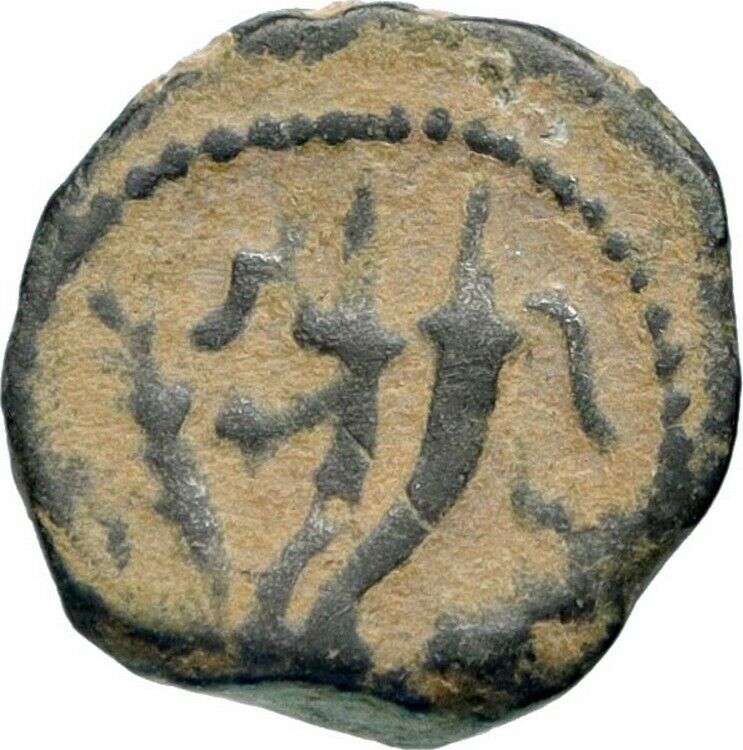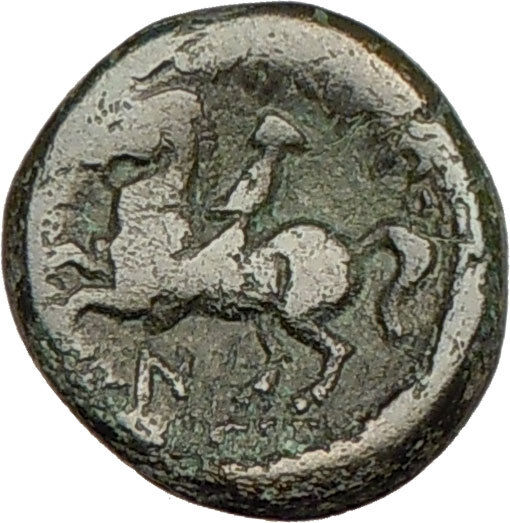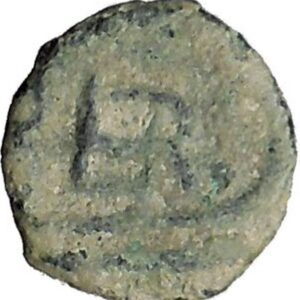|
Greek city of Herakleia in Lucania
Bronze 12mm (2.86 grams) Struck 3rd-1st centuries B.C.
Reference: Van Keuren 144; HN Italy 1437
Certification: NGC Ancients VF 4281760-002
Head of Athena right, wearing Corinthian helmet.
I-HPAKΛEIΩN, merman-like marine divinity, possibly Glaukos, standing right, holding shield and spear.
Founded jointly by Taras and Thourioi in 433 B.C., it later became the seat of the general assembly of the Italiot Greeks: finally surrendered to the Romans in 272 B.C.
You are bidding on the exact item pictured, provided with a Certificate of Authenticity and Lifetime Guarantee of Authenticity.
 Athena or Athene (Latin: Minerva), also referred to as Pallas Athena, is the goddess of war, civilization, wisdom, strength, strategy, crafts, justice and skill in Greek mythology. Minerva, Athena’s Roman incarnation, embodies similar attributes. Athena is also a shrewd companion of heroes and the goddess of heroic endeavour. She is the virgin patron of Athens. The Athenians built the Parthenon on the Acropolis of her namesake city, Athens, in her honour (Athena Parthenos). Athena’s cult as the patron of Athens seems to have existed from the earliest times and was so persistent that archaic myths about her were recast to adapt to cultural changes. In her role as a protector of the city (polis), many people throughout the Greek world worshiped Athena as Athena Polias (“Athena of the city”). Athens and Athena bear etymologically connected names. Athena or Athene (Latin: Minerva), also referred to as Pallas Athena, is the goddess of war, civilization, wisdom, strength, strategy, crafts, justice and skill in Greek mythology. Minerva, Athena’s Roman incarnation, embodies similar attributes. Athena is also a shrewd companion of heroes and the goddess of heroic endeavour. She is the virgin patron of Athens. The Athenians built the Parthenon on the Acropolis of her namesake city, Athens, in her honour (Athena Parthenos). Athena’s cult as the patron of Athens seems to have existed from the earliest times and was so persistent that archaic myths about her were recast to adapt to cultural changes. In her role as a protector of the city (polis), many people throughout the Greek world worshiped Athena as Athena Polias (“Athena of the city”). Athens and Athena bear etymologically connected names.
Glaucus was a Greek prophetic sea-god, born mortal and turned immortal upon eating a magical herb. It was believed that he commonly came to the rescue of sailors and fishermen in storms, having once been one himself.
Parents
Glaucus’ parentage is different in the different traditions, which Athenaeus lists:
- Theolytus the Methymnaean, in his Bacchic Odes – Copeus
- Promathides of Heraclea, in his Half Iambics – Polybus of Sicyon and Euboea
- Mnaseas, in Book III of his History of the Affairs of Europe – Anthedon and Alcyone
- Euanthes, in his Hymn to Glaucus – Poseidon and a Naiad nymph
 Origins Origins
The story of Glaucus’ deification was dealt with in detail by Ovid in Metamorphoses and briefly referenced by many other authors. According to Ovid, Glaucus began his life as a mortal fisherman living in the Boeotian city of Anthedon. He discovered by accident a magical herb which could bring the fish he caught back to life, and decided to try eating it. The herb made him immortal, but also caused him to grow fins instead of arms and a fish’s tail instead of legs (though some versions say he simply became a merman-like being), forcing him to dwell forever in the sea. Glaucus was initially upset by this side-effect, but Oceanus and Tethys received him well and he was quickly accepted among the deities of the sea, learning from them the art of prophecy.
John Tzetzes adds to the above story that Glaucus became “immortal, but not immune to aging”.
In an alternate, non-extant version cited in Athenaeus (with reference to Nicander’s Aetolian History), Glaucus chased a hare on mount Oreia until the animal fell down almost dead, then carried his prey to a spring and rubbed it with a bunch of grass that was growing about. The herb brought the hare back to life. Glaucus then tasted it himself and fell into a state of “divine madness”, in which state Zeus made him fling himself into the stormy sea.
Athenaeus also informs that in yet another version followed by Possis of Magnesia, Glaucus (rather than Argus) was the builder and the pilot of Argo. During a naval battle between the Argonauts and the Etruscans, he fell into the sea and by the will of Zeus became a sea god.
The herb
Alexander of Aetolia, cited in Athenaeus, related that the magical herb grew on the island Thrinacia sacred to Helios and served as a remedy against fatigue for the sun god’s horses. Aeschrion of Samos informed that it was known as the “dog’s-tooth” and was believed to have been sowed by Cronus.
Prophetic abilities
Athenaeus, referring to Aristotle’s non-extant Constitution of Delos, related that Glaucus settled in Delos together with the Nereids and would give prophecies to whoever asked for them. He also mentions, this time with reference to Nicander, that Apollo was believed to have learned the art of prophecy from Glaucus.
Advisor to seafarers
An encounter of Glaucus with the Argonauts was described by Diodorus Siculus and Philostratus the Elder. When the Argonauts were caught in a storm, Orpheus addressed the Cabeiroi with prayer; the wind ceased, and Glaucus appeared. He followed the Argo for two days and prophesied to Heracles and the Dioscuri their future adventures and eventual deification. He addressed other members of the crew individually as well, especially noting that he was sent to them thanks to Orpheus’ prayer, and instructing them to further pray to the Cabeiroi. In Apollonius Rhodius’ version, Glaucus appeared at the point when Telamon quarreled with Jason over Heracles and Polyphemus being left behind on the coast of Bithynia where Hylas had been lost. Glaucus reconciled the two by letting them know that it had been ordained for Heracles to return to Eurystheus’ court and complete his Twelve Labours, and for Polyphemus to found Cius, while Hylas had been abducted by a nymph and married her. Cf. also above for the version that made Glaucus an Argonaut himself.
In Euripides’ play Orestes Glaucus appeared in front of Menelaus on the latter’s voyage home, announcing to him the death of his brother Agamemnon by the hand of Clytaemnestra.
Love life
According to Ovid and Hyginus, Glaucus fell in love with the beautiful nymph Scylla and wanted her for his wife, but she was appalled by his fish-like features and fled onto land when he tried to approach her. He asked the witch Circe for a potion to make Scylla fall in love with him, but Circe fell in love with him instead. She tried to win his heart with her most passionate and loving words, telling him to scorn Scylla and stay with her. But he replied that trees would grow on the ocean floor and seaweed would grow on the highest mountain before he would stop loving Scylla. In her anger, Circe poisoned the pool where Scylla bathed, transforming her into a terrible monster with twelve feet and six heads.
Euanthes and Theolytus of Methymna also recorded an affair between Glaucus and Ariadne: according to Athenaeus who cites these authors, Glaucus seduced Ariadne as she was abandoned by Theseus on Dia (Naxos). Dionysus then fought Glaucus over Ariadne and overpowered him, binding his hands and feet with grape vines; he, however, released Glaucus when the latter disclosed his own name and origin.
According to Mnaseas, again cited in Athenaeus, Glaucus abducted Syme on a journey back from Asia, and had the island Syme named after her; according to Aeschrion of Samos, Glaucus was the lover of the semi-historical Hydne.
Glaucus was reported to have had male lovers as well: Nicander in Europia mentioned Nereus as one, while Hedylus of Samos (or Athens) wrote that it was out of love for Melicertes that Glaucus threw himself into the sea. Yet according to Nicanor of Cyrene’s Change of Names, Glaucus and the deified Melicertes were one and the same.
It is not known if Glaucus had any children, but Pausanias mentions Glaucus of Carystus as an alleged descendant of Glaucus the sea god. Virgil seems to indicate the Cumaean Sibyl, Deiphobe, as a daughter of Glaucus.
In literature and art
Aeschylus wrote a play on Glaucus, entitled Glaucus Pontius (“Glaucus of the Sea”), now lost. A work entitled Glaucus also belonged to Callimachus (it is unclear though which Glaucus was its subject).
The Roman author Velleius Paterculus made mention of Plancus, who performed in the role of Glaucus at a feast.
Scylla et Glaucus, an opera by Jean-Marie Leclair, was based on the myth of Glaucus’ love for Scylla recorded in Ovid.
A statue of Glaucus was installed in 1911 in the middle of the Fontana delle Naiadi, Mario Rutelli’s fountain of four naked bronze nymphs, located in the Piazza Repubblica, Rome.
Heraclea (also Heracleia or Herakleia; Greek: Ἡράκλεια) was an ancient city of Magna Graecia, situated in Lucania on the Gulf of Tarentum (modern Gulf of Taranto), but a short distance from the sea, and between the rivers Aciris (modern Agri) and Siris (modern Sinni), the site of which is located in the modern comune of Policoro, Province of Matera, Basilicata, Italy.

|









 Athena or Athene (Latin: Minerva), also referred to as Pallas Athena, is the goddess of war, civilization, wisdom, strength, strategy, crafts, justice and skill in Greek mythology. Minerva, Athena’s Roman incarnation, embodies similar attributes. Athena is also a shrewd companion of heroes and the goddess of heroic endeavour. She is the virgin patron of Athens. The Athenians built the Parthenon on the Acropolis of her namesake city, Athens, in her honour (Athena Parthenos). Athena’s cult as the patron of Athens seems to have existed from the earliest times and was so persistent that archaic myths about her were recast to adapt to cultural changes. In her role as a protector of the city (polis), many people throughout the Greek world worshiped Athena as Athena Polias (“Athena of the city”). Athens and Athena bear etymologically connected names.
Athena or Athene (Latin: Minerva), also referred to as Pallas Athena, is the goddess of war, civilization, wisdom, strength, strategy, crafts, justice and skill in Greek mythology. Minerva, Athena’s Roman incarnation, embodies similar attributes. Athena is also a shrewd companion of heroes and the goddess of heroic endeavour. She is the virgin patron of Athens. The Athenians built the Parthenon on the Acropolis of her namesake city, Athens, in her honour (Athena Parthenos). Athena’s cult as the patron of Athens seems to have existed from the earliest times and was so persistent that archaic myths about her were recast to adapt to cultural changes. In her role as a protector of the city (polis), many people throughout the Greek world worshiped Athena as Athena Polias (“Athena of the city”). Athens and Athena bear etymologically connected names. Origins
Origins





